Wilmer Stultz, July 2, 1929
(Source: NASM)
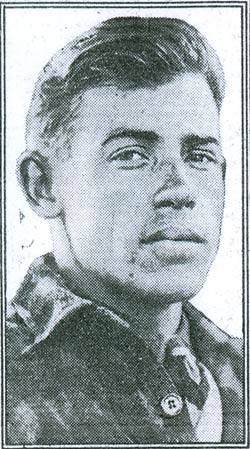 |
Wilmer Lower "Bill" Stultz was born in Williamsburg, PA on April 11, 1900. He enlisted in the U.S. Army August 22, 1917, advanced to the rank of sergeant in the 634th Aero Supply Squadron, and was honorably discharged March 31, 1919.
According to information in his NASM biographical file (cited, left sidebar), he married Mildred Botts of Middletown, PA August 4, 1919. That same year in December, he enlisted in the U.S. Navy. He was sent for special training in the naval flight school at Pensacola, FL. He received training in seaplanes, navigation, aerology, meteorology and radio communications. He was graduated seventh in his class of 100 students, sent to Hampton Roads, VA, and honorably discharged again on December 1, 1922.
Below, courtesy of Stultz' grand nephew, is an image of the cover of his Navy flight log book covering most of 1921.
Bill Stultz, Naval Aviator's Flight Log Book Cover, 1921 (Source: Stultz Family)
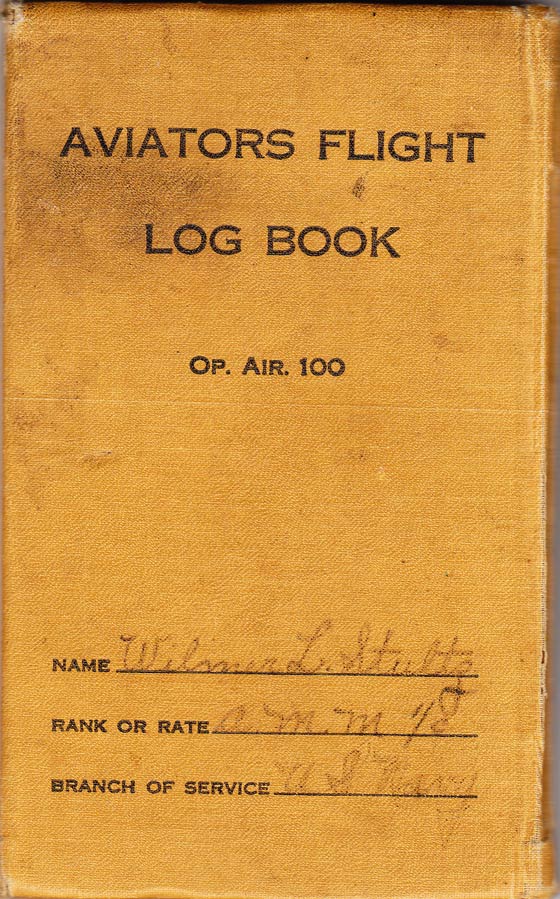 |
Unfortunately, this log does not include his flight to Tucson or his trans-Atlantic flight with Amelia Earhart (see below). One page, below, documents his flights during most of June, 1921. He flew an aircraft identified as A-3795. According to Joe Baugher's site, A-3559 through A-4038 were early amphibious bombers, specifically Naval Aircraft Factory F-5Ls. A photo of the large F-5L is at aerofiles.com.
Bill Stultz, Naval Aviator's Flight Log Book, June, 1921 (Source: Stultz Family)
 |
After his Navy service, he took a job with the Curtiss Export Company during 1923, based at Rio de Janeiro training Brazilians to fly Curtiss aircraft. He was associated with the Atlantic (Fokker) Aircraft Company and personally conducted tests on the Josephine Ford, the Byrd North Pole plane. With Atlantic, he became Anthony Fokker's (Fokker and his wife were Register passengers) private pilot.
Stultz was known as an "able pilot." But many news articles in Stultz's NASM file report narrow escapes from disaster. In 1924, he was forced to jump from an aircraft (presumably with a parachute; the article didn't say) at low altitude because of low weather and fog that he was unaware of when he took off. In September, 1928, while working for Sikorsky (see below) he made the first ever loop in a 12-passenger amphibian. His passenger was Carl Schneider (see below), German war ace (WWI). At 1,200 feet, Schneider suggested the loop, they fastened their belts, opened the engines, dived to 140MPH and executed the loop. Fortunately the airplane held together, as it was not designed for aerobatics. The event was documented in the NY Herald Tribune, September 27, 1928, available in Stultz's NASM file.
Although not that well-known himself, Stultz mingled in the heady company of significant Golden Age personalities during the mid- to late 1920s. He first gained national publicity when he was approached in March, 1928 by Richard Byrd to act as assistant pilot on Byrd's proposed flight over the South Pole in the Fokker named Friendship. The Friendship is not a Register airplane, but please follow the link to the Josephine Ford, above, to understand the curious confusion around these two machines.
I'm not sure of the circumstances around his decision, but Stultz declined that opportunity because of the length of time he would have to be away. Another offer soon came his way. Friendship was purchased from Bryd by a steel magnate's daughter for her own record-setting flight across the Atlantic. She did not make that flight.
But, according to the NY Herald Tribune of May 19, 1929 (this is the correct date, reporting a year after the fact), Stultz was selected by George Palmer Putnam to fly the Friendship across the Atlantic. The owner of Friendship had suggested to Putnam that his soon-to-be wife, Amelia Earhart (they married in 1931), make that flight in her place. And the rest is history.
On June 17-18, 1928, Stultz, mechanic Louis Gordon (1901-1964), and Earhart (1897-1937) as passenger in the back, flew across the Atlantic from Trepassey Bay, Newfoundland to Burry Port, Wales. The photograph below, from the New York Times of June 19, 1928, shows Friendship upon departure from Trepassey Bay. Note it is still shedding water from its pontoons, and the propellers are already nicely synchronized.
Friendship, Departing Newfoundland, June 17, 1928
(Source: NY Times)
 |
The Herald Tribune (op. cit.) cites that Earhart, "...modestly disclaimed credit for success of the venture, and always referred those who tried to praise her when she returned to America to her pilot and his assistant, Lou Gordon." The New York Evening Journal of July 2, 1929 (again reporting a year after the flight) even cites Stultz as the, "...co-pilot for Amelia Earhart...." Fair enough. But she was still the first woman to fly across the Atlantic, even though not as pilot in command. She would, however, perform that feat on May 21, 1932, flying a Register airplane, the Lockheed Vega NC7952.
Below, courtesy of Stultz' grand nephew, is an image of the cover of a booklet commemorating the trans-Atlantic flight. This celebration was held in Stultz' hometown of Williamsburg, PA. Thanks to site visitor C. Thornton and her son, S. McLemore, you may download the entire, informative booklet at the link (PDF, 3Mb). From it you will learn more about the early life of Wilmer Stultz, as well as see photographs of him and his home town, Earhart, Gordon and their airplane. Whereas the cover below is unsigned, the one on the downloadable copy is autographed by Stultz and Gordon. This is a great memento, please download it, take a look, and enjoy the whole thing, including the mouse nibblings along the edges!
Wilmer Stultz, Commemorative Booklet Cover, July 18, 1928 (Source: Stultz Family)
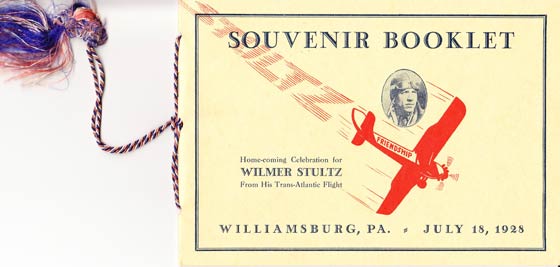
|
Another festival was held at Middletown, PA and a postal cachet was issued in commemoration. Below, from site visitor Jeff Staines, is a scan of the cachet dated July 28, 1928.
Stultz Day Cover, July 28, 1928, Middletown, PA (Source: Staines)
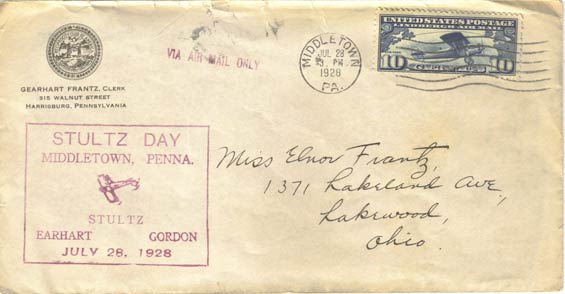 |
Below, the reverse of the envelope showing Stultz' autograph.
Stultz Day Cover (Reverse), July 28, 1928, Middletown, PA (Source: Staines)
.jpg) |
Stultz enjoyed the fruits of his trans-Atlantic fête and honors. He had the airfield at Tipton, PA named after him. It remained Stultz Field until 1951 when it was renamed Peterson Field for the reasons cited in the photograph, below left, courtesy of site visitor Don Struke. Note, this Peterson Field has no relationship whatsoever with the Peterson Field, Colorado Springs, CO that is one of our favorite Web sites. The history of Stultz Field with many photographs is at the link.
Renaming of Stultz Field, 1951 (Source: Struke)
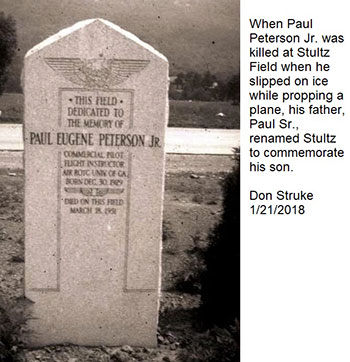 |
He also accepted the post of test pilot for the Sikorsky Manufacturing Company where he did his loop with the amphibian (see above). In late 1928, Stultz became Chief Pilot for John Hay Whitney (August 17, 1904 – February 8, 1982) based in Brooklyn, NY.
It was this employment with Whitney that brought Stultz to land at Tucson. He visited twice, on January 1 and February 27, 1929, flying Whitney's Sikorsky S-38, NC8005. In January he brought a single passenger, Carl Schneider (the WWI ace, see above). They were westbound from El Paso, TX and they remained in Tucson until January 30th (weather?) before continuing their journey to Los Angeles, CA. His February visit was on an eastbound flight from Los Angeles, CA to El Paso. He carried two unidentified passengers. No purpose was given in the Register for these flights.
Whether this flight was a Whitney assignment or not is not clear. The New York Sun of April 19, 1929 has Stultz carrying radio announcer Graham MaNamee from Roosevelt Field to York, PA in a Fairchild aircraft. Stultz had about ten weeks to live after this flight.
On July 1, 1929, at about 12:30PM at Roosevelt Field, LI, NY, Stultz took off with two acquaintances as passengers in a Waco Taperwing (NC8577; not a Register airplane). According to the Newark (NJ) Evening News of that day, the aircraft belonged to Whitney and he had loaned it to Stultz , "... to do stunt flying." Other sources reported that Stultz owned the airplane, having bought it from Whitney.
One passenger, Charles (reported as "Edward" in other newspapers) Harwood age 24, was a road inspector in Queens, NY. The other passenger was Patrick Costiluchi (first name reported as Ernest; last name Constiunchi or Pasquale Costellucio in other newspapers), a 26 year-old Fordham Law graduate, was working for a local construction company. The passengers were reported to have, "... begged a ride...." Neither of them were pilots, nor had they been more than once or twice in airplanes.
It is not clear from any of the news articles in his NASM biographical folder which stunts were to be performed by Stultz, or if the flight was planned at all. The New York Times of July 2nd reported that he executed a roll and recovered at about 600 feet and entered another, recovering at abut 250 feet. The airplane had only been in the air about 15 minutes, and was at 200 feet when it began to climb again, slowed, began sliding backwards in the manner of the "Falling Leaf" maneuver (which should never be purposely performed at such low altitude), rotated nose down, and plunged into the ground. Both passengers were killed immediately, and Stultz died shortly after as he arrived at the Mineola, LI hospital.
A controversy over the cause of the crash began almost immediately. The New York Times (op.cit.) further reported, "Experts attributed the accident ot reckless flying and disregard of safety regulations by Stultz, who, daring flier that he was, had a reputation for caution in the air." It was further reported that two left shoes were found jammed under the rudder bar in the front cockpit where the passengers sat, which jammed the rudder. The Times further reported that discovery of the shoes, "... led to the theory that the boys may have thrust their feet under the bar to brace themselves when the ship was tilted at an angle, without knowing that in doing so they left Stultz powerless to land his little sport biplane safely."
Wilmer and Mildred Botts Stultz, July 2, 1929 (Source: NASM)
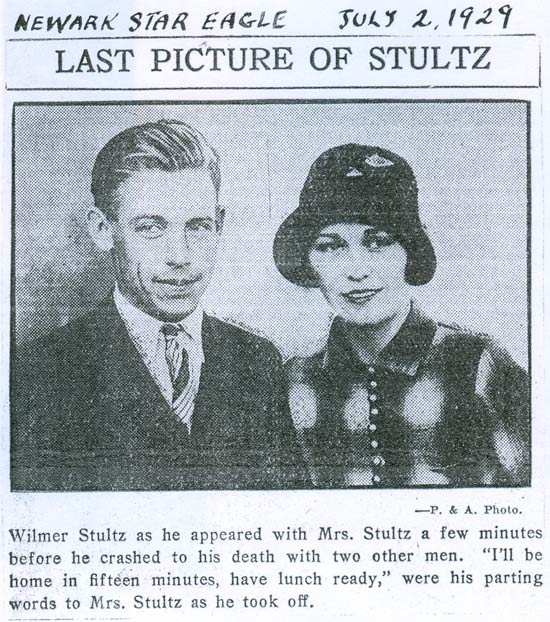 |
According to regulations of the time, Stultz should have disconnected control links from the front cockpit before carrying novice passengers during aerobatic maneuvers. Chapter 1, Section C of the Department of Commerce air commerce regulations provided that, "...dual control on airplanes flying passengers shall be so constructed or arranged as to prevent passengers from interfering with the course of the plane's flight."
But it wasn't over yet. The Newark Star-Eagle of July 5, 1929 headlined, "Stultz 'Very Drunk' At Time of Death in Plane With Friends", and reported , "...there was a large amount of alcohol in the stomach and brain.... and the conclusion was the man was very drunk at the time of his death." And, with prohibition being the law of the land at the time, and local elected lawmakers always looking for press, "The district attorney's office announced it would commence a campaign against drunken flying a the Nassau County fields, although the announcement said there was little intoxication on the part of pilots." Further reporting listed steps against local bootleggers, and against "blind tigers"/speakeasies near Roosevelt Field.
Then the New York American of Sunday, July 7, 1929 reported that eye witnesses had seen the two passengers fighting with the pilot, and he with them, during the last seconds of their flight. This "news" was not corroborated or played out in any of the other articles in Stultz's NASM folder.
Ten days later, cooler minds prevailed. The NY Times headlined, "Finds No Evidence of Stultz Drinking." The coroner's inquest held on July 17th offered no support to the allegation of drunkeness. The decision was based on eyewitness testimony from numerous individuals who had been with Stultz immediately before the fatal flight. They testified they had not detected evidence of alcohol or alcohol-influenced behavior, there being, "...no evidence to show that the pilot was unable to fly."
Reading between the lines, it was clear that the local district attorney had a vendetta against the "cheaper" speakeasies in his jurisdiction. He explained that, "...the autopsy was ordered by one of his assistants, and that the discovery of alcohol, and certain other [unidentified] facts, if true [emphasis], show that a certain speakeasy was specializing in supplying liquor to aviators and automobile drivers, resulting in the daily risking of the lives of passengers as well as pilots." Politics as usual.
Preachy Take Away: Many Register pilots made hazardous flights successfully (see the "Winners' Viewpoints" reference in the left sidebar). There is no shortage of examples of them achieving records by stretching the endurance, strength and performance envelopes of their machines and of themselves.
If you examine the successes, the single most important correlate of success is preparation and knowledge of machine and self. In these cases with robust preparation, what appears to be a bold flight is really low risk because preparation made it so. Without knowledge and preparation, there is an old saying among pilots that goes something like this, "There are old pilots, and there are bold pilots. But there are no old, bold pilots." Stultz was 29 years old when he died.
---o0o---
Dossier 2.1.153
THIS PAGE UPLOADED: 01/10/10 REVISED: 03/19/10, 01/31/11, 02/11/12
|

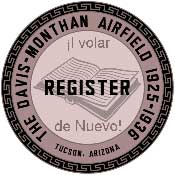






.jpg)

